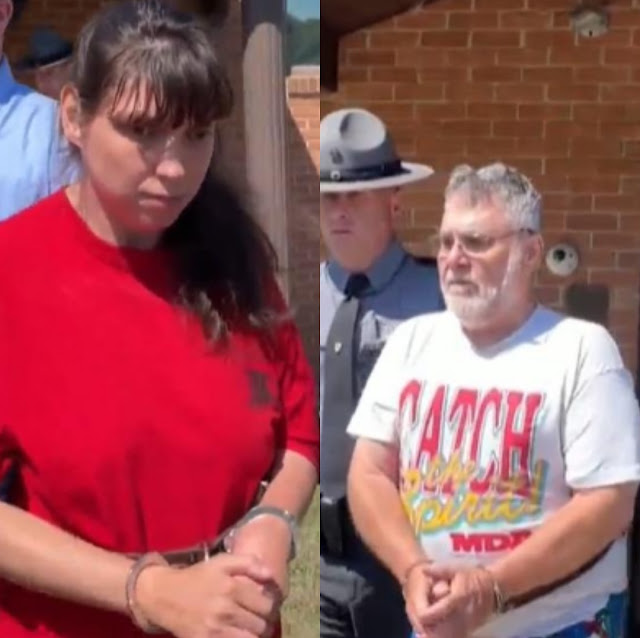In a deeply disturbing case that has shocked communities and drawn widespread attention, a Pennsylvania couple, James Russell Kahl, 65, and Carly Kahl, 41, were arrested on September 3, 2025, after authorities discovered their five children living in what has been described as a “sickening” and “deplorable” feces-covered “dungeon” in their Redstone Township home. The children, aged between 5 and 14, were found locked in a bedroom with no beds, boarded-up windows, and walls smeared with feces, in conditions so horrific that Pennsylvania State Trooper Ally Wilson described them as “sickening.” The Kahls face multiple charges, including endangering the welfare of children, aggravated assault, reckless endangerment, use of an incapacitation device, and drug-related offenses. This article provides a comprehensive examination of the incident, the investigation, the broader context of child welfare in Pennsylvania, and the implications for the affected children and society.
The Discovery: A House of Horrors
The harrowing discovery was made on August 8, 2025, when Pennsylvania State Police were called to assist Fayette County Children and Youth Services (CYS) in responding to a complaint about the welfare of children at a home on Willis Avenue in Redstone Township, approximately 46 miles south of Pittsburgh. The initial report, likely from a concerned family member or neighbor, prompted a visit to the Kahl residence, where authorities encountered a scene described as a “house of horrors.” The five children, ranging in age from 5 to 14, were found confined to a single bedroom that functioned as a “dungeon,” with three deadbolt locks on the outside of the door and no interior handle, effectively trapping them inside.
The conditions inside the room were appalling. There were no beds, forcing the children to sleep on the floor. The windows were boarded up, preventing natural light and ventilation. The walls were smeared with feces, and the room was infested with fleas. Investigators noted a severe lack of food and clothing, with the children having access to only minimal supplies. Most disturbingly, a surveillance camera was hardwired from the bedroom to the father’s room, allowing James Kahl to monitor the children’s every move. This setup, combined with the deadbolt locks, suggested a deliberate and systematic effort to isolate and control the children, raising serious questions about the extent of the abuse they endured.
Trooper Ally Wilson, speaking to local outlet WTAE, expressed the emotional toll of the discovery, stating, “It’s sickening – that’s the only word that I can use to describe what we saw and what those children went through.” The children were immediately removed from the home by CYS and placed in protective custody, where they are receiving medical and psychological care. The Kahls were arrested on September 3, following the execution of a search warrant, and are currently detained without bail, facing a litany of charges that reflect the severity of their alleged actions.
The Investigation: Uncovering a Pattern of Abuse
The investigation into the Kahls’ actions began with the initial CYS complaint on August 8, but it was the subsequent search warrant executed on September 3 that revealed the full extent of the abuse. Pennsylvania State Police, in collaboration with CYS, uncovered additional evidence that painted a grim picture of the children’s living conditions. In addition to the locked bedroom and surveillance system, authorities recovered a stun gun, a replica pistol, drugs, and drug paraphernalia from the home, suggesting a broader environment of neglect and potential criminal activity.
Court documents obtained by WPXI reveal that James Kahl was unapologetic about the locks on the bedroom door, telling troopers and a CYS caseworker that he would “not be removing the locks from the bedroom door for any reason.” This statement, coupled with the physical evidence, indicates a calculated intent to confine the children, raising concerns about the psychological and physical impact of their prolonged isolation. The presence of drugs and weapons in the home further complicates the case, suggesting that the children were exposed to additional risks beyond the deplorable living conditions.
The investigation also shed light on James Kahl’s prior run-ins with the law. Court records show that he pleaded guilty to a harassment charge in 2006, was arrested for driving under the influence in the same year, and faced a probation violation in 2012. These incidents, while not directly related to child abuse, suggest a history of legal troubles that may have contributed to the environment in which the children were raised. Carly Kahl’s background, however, remains less documented, leaving questions about her role in the alleged abuse and the dynamics of the couple’s relationship.
Fayette County District Attorney Mike Aubele praised the collaborative efforts of CYS and the Belle Vernon State Police, noting that the arrests were the result of a thorough investigation that continued long after the children were removed from the home. “We are very happy with our Children and Youth Services, who removed these children, and our Belle Vernon state police that continued this investigation long after the children were removed to make the arrest that they did today,” Aubele told KDKA. He also emphasized the importance of community vigilance, stating, “Law enforcement cannot be in every household and every single minute of every day; we need people to come forward and think of these children.”
The Children: Immediate Needs and Long-Term Recovery
The five children, whose identities have been protected due to their ages and the sensitive nature of the case, are now in the care of CYS, where they are receiving comprehensive support. Initial medical assessments likely focused on addressing malnutrition, flea bites, and any infections resulting from the unsanitary conditions. The psychological impact of their confinement, however, may be even more profound. Child welfare experts note that prolonged isolation, lack of proper care, and exposure to abusive environments can lead to severe trauma, anxiety, and developmental delays, particularly in young children.
The children’s ages—ranging from 5 to 14—suggest a range of developmental stages, each with unique needs. The youngest, a 5-year-old, may struggle with trust and attachment issues, while the older children may grapple with feelings of shame, anger, or guilt. The presence of a surveillance camera adds another layer of trauma, as the children were likely aware of being constantly watched, eroding any sense of privacy or safety. Child psychologists emphasize the importance of trauma-informed care, which includes therapy, a stable environment, and opportunities to rebuild trust and self-esteem.
CYS is likely working to place the children in foster care or with relatives, a process that requires careful consideration to ensure their safety and well-being. The agency’s role extends beyond immediate rescue, encompassing long-term planning to support the children’s education, mental health, and social integration. Community organizations and nonprofits may also play a role, providing resources such as counseling, recreational programs, and academic support to help the children recover and thrive.
The Burrows case, while extreme, is not an isolated incident. In Pennsylvania, CYS agencies handle thousands of child abuse and neglect cases annually, with over 44,000 reports investigated in 2024 alone, according to the Pennsylvania Department of Human Services. The state has made strides in improving its child welfare system, but challenges such as underfunding, caseworker burnout, and systemic gaps remain. The Kahls’ case underscores the critical role of community reporting, as it was a tip from an individual—possibly a family member—that triggered the investigation and ultimately saved the children.
The Broader Context: Child Abuse and Neglect in the United States
The Kahls’ case is a stark reminder of the pervasive issue of child abuse and neglect in the United States. According to the U.S. Department of Health and Human Services, approximately 600,000 children are victims of abuse or neglect each year, with neglect being the most common form. Physical abuse, emotional abuse, and sexual abuse also contribute to the crisis, with long-term consequences for victims, including mental health disorders, substance abuse, and difficulties forming healthy relationships.
The conditions described in the Kahl household—locked rooms, lack of basic necessities, and unsanitary environments—are characteristic of severe neglect, a form of abuse that can be as damaging as physical violence. The use of surveillance and deadbolt locks suggests an element of psychological control, a tactic often used in abusive households to instill fear and compliance. The presence of drugs and weapons further indicates a chaotic and dangerous environment, compounding the risks to the children’s safety.
Pennsylvania, like many states, has faced scrutiny over its child welfare system. High-profile cases, such as the 2011 Penn State child abuse scandal, have highlighted the need for stronger protections and oversight. In recent years, the state has implemented reforms, including increased training for caseworkers and improved coordination between agencies. However, the Kahls’ case reveals that significant challenges remain, particularly in identifying and intervening in cases of hidden abuse.
Nationally, the issue of child welfare intersects with broader social issues, including poverty, substance abuse, and mental health. The Kahls’ possession of drugs and drug paraphernalia suggests that substance abuse may have played a role in their neglectful behavior, a common factor in child welfare cases. Addressing these root causes requires a multifaceted approach, including access to addiction treatment, mental health services, and economic support for families in crisis.
Comparative Cases: Other Instances of Severe Child Neglect
The Kahls’ case bears similarities to other recent incidents of severe child neglect and abuse. In May 2025, a South Carolina couple was arrested after their 8-month-old baby was found living among 47 neglected animals, including a decaying goat carcass, in a home filled with feces and ammonia. The conditions, described as “one of the most horrific” by police, mirror the unsanitary environment in the Kahl household. The South Carolina case also highlighted the role of community reporting, as neighbors alerted authorities to the situation.
Another comparable case occurred in Spain in April 2025, where a German couple was arrested for locking their three children in a “house of horrors” since 2021, citing fears of COVID-19. The children, aged 8 to 10, lived among trash, feces, and medication, with limited access to the outside world. Like the Kahls, the parents exerted extreme control over their children, highlighting a pattern of isolation and neglect in such cases.
These incidents underscore the importance of early intervention and the role of community vigilance in protecting vulnerable children. They also highlight the need for systemic changes to ensure that cases of abuse are identified before they escalate to such extreme levels.
Legal and Social Implications
The arrests of James and Carly Kahl mark the beginning of a legal process that will likely be closely watched. The charges they face—endangering the welfare of children, aggravated assault, reckless endangerment, use of an incapacitation device, and drug offenses—carry significant penalties. In Pennsylvania, endangering the welfare of children is a felony, with potential sentences of up to seven years in prison per count. Aggravated assault and reckless endangerment also carry substantial penalties, particularly given the number of victims and the severity of the conditions.
The case is likely to spark discussions about sentencing and rehabilitation. While incarceration may serve as a deterrent, experts argue that addressing the underlying issues—such as potential substance abuse or mental health disorders—is critical to preventing recidivism. The Kahls’ detention without bail reflects the seriousness of the charges and the perceived risk to the community, but their long-term outcomes will depend on the evidence presented in court and the effectiveness of their defense.
From a social perspective, the case highlights the importance of community awareness and intervention. Aubele’s call for people to “come forward and think of these children” underscores the role of neighbors, relatives, and educators in reporting suspected abuse. Organizations like the Childhelp National Child Abuse Hotline, which offers confidential support in over 170 languages, provide critical resources for reporting and addressing abuse. The hotline’s number, 1-800-4-A-Child, has been widely shared in coverage of the case, encouraging others to act if they suspect a child is in danger.
The Path Forward: Healing and Prevention
For the five Kahl children, the road to recovery will be long and complex. Trauma-informed care, including therapy and stable caregiving, will be essential to help them process their experiences and rebuild their lives. Foster care systems in Pennsylvania face challenges, including a shortage of foster homes and high caseloads for social workers, but the state’s commitment to child welfare reform offers hope for better outcomes.
Preventing similar cases requires a combination of community vigilance, systemic improvements, and policy changes. Strengthening child welfare agencies, increasing funding for social services, and raising awareness about the signs of abuse are critical steps. Schools, which often serve as a first line of defense in identifying neglect, can play a key role in monitoring children’s well-being and reporting concerns.
The case also raises questions about the role of technology in abuse. The use of a surveillance camera to monitor the children highlights how tools intended for security can be weaponized in abusive contexts. This aspect of the case may prompt discussions about regulating such technologies and ensuring they are not used to harm vulnerable individuals.
Conclusion
The arrest of James and Carly Kahl for locking their five children in a feces-covered “dungeon” is a chilling reminder of the hidden horrors that can exist behind closed doors. The bravery of the individual who reported the situation, combined with the swift action of CYS and the Pennsylvania State Police, ensured that the children were rescued from unimaginable conditions. As the legal process unfolds, the focus must remain on supporting the children’s recovery and addressing the systemic issues that allowed such abuse to persist.
This case serves as a call to action for communities, policymakers, and individuals to prioritize child welfare and intervene when signs of neglect or abuse emerge. The resilience of the Kahl children, now safe in protective custody, offers hope that with the right support, they can overcome their traumatic past and build brighter futures. For society, the challenge is to learn from this tragedy, strengthen protections for vulnerable children, and ensure that no child endures such suffering again.






